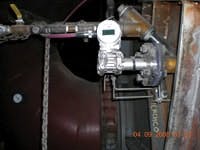Protecting the Wild Diaphragm with Nanotech
Some of the fluids used in the process industries are, well, difficult. Slurries, for example, can be abrasive, corrosive or both. Neither physical property is particularly good for piping, valves or instruments in the line. Pipe and valve trim can be made relatively abrasion-and-corrosion-resistant. Unfortunately, the materials that are going to withstand abrasion or corrosion do so by being relatively hard and relatively thick and inflexible. But this approach just doesnt work for pressure transmitter diaphragms. Anything that adds enough protection against abrasion or corrosion will probably make the diaphragm too stiff to work properly as a diaphragm.
ABB has announced a new diaphragm material, Diaflex, made by a completely new process. We hear about nanotechnology, but we havent experienced many of its benefits until recently.
Diaflex, says product manager Allen W. Hood, is a nanostructured material with a hardness of 4,000 hv, which is similar to the diamond. Diaflex is produced via a patented process that consists of a quaternary coating based on titanium and silicon (SiTiN) of the nitrides class.
Diaflex is deposited using a technique called PVD (physical vapor deposition) on the standard 316L stainless steel diaphragm. The Diaflex coating thickness is only 3 μm to 5 μm thick, so it allows a very good spring rate value, according to ABB. Diaflexs physical characteristics remain stable, between -100 °C and +700 °C (-148 °F to +1292 °F), Hood reports, but the transmitter maximum working process temperatures are, as always, limited by the fill fluid.
For more information, visit www.abb.com/instrumentation or call 215.674.6000.


